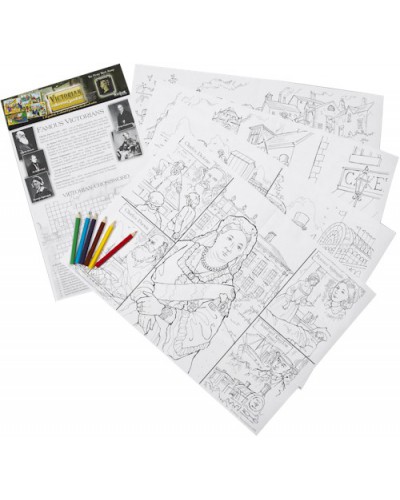Product Description: The Victorian Colouring Posters consists of four A3 size colouring sheets, six colouring pencils and a Victorian factsheet.
The colouring posters include a single image of a Victorian street scene and an industrial scene, and two posters depicting multiple images. The first depicts the key figures of Victorian times, Queen Victoria, Charles Dickens, Charles Darwin, Florence Nightingale and Isambard Kingdom Brunel. The other poster depicts Victorians at the seaside, at the Great Exhibition, exploring and fighting a battle.
The factsheet explains about Queen Victoria, her coins, the industrial revolution, famous Victorians and there is also a crossword to complete. There is a colourful header card that has pictures showing how the posters could be coloured in and information on the Penny Black stamp and the Victoria Cross medal. All are held in a clear cellophane bag.
Information: Victoria was born in Kensington Palace in 1819. She was Queen of the United Kingdom of Great Britain and Ireland (1837-1901) and Empress of India (1876-1901). Her reign was the longest of any monarch in British history and came to be known as the Victorian era.
Queen Victoria came to the throne when she was only 18 years of age on June 20, 1837. Her coronation was a year later on 28 June 1838 at Westminster Abbey. At the age of 21, she married her cousin, Albert Duke of Saxe-Coburg Gotha, a German Prince. They married on the 10th February 1840 at the Chapel Royal in St. James’s Palace and had 9 children. Albert died in 1861 at the young age of 42 and from then on Victoria wore black clothes.
Queen Victoria had many homes. She lived in Windsor Castle, Osbourne House (Isle of Wight) and Balmoral Castle. She was the first monarch to live in Buckingham Palace. Victoria died on 22 January, 1901 at Osbourne House on the Isle of Wight.
By 1837 Britain was undergoing extensive industrial expansion. The Industrial Revolution had begun in the late 18th century and completely changed the lifestyle of Victorian Britain. When Queen Victoria ascended the throne in 1837, Britain had already started its transformation into a world power. Agriculture was slowly being pushed aside for manufacturing jobs. By the end of the 1800’s, 80 percent of England’s population lived in cities.
Coal and iron made the Industrial Revolution possible. Coal furnaces boiled water to produce steam which drove new machinery. Steam-powered cotton factories enabled Victorian Britain to produce more than half the world’s supply of cotton and cotton became Britain’s leading industry. Coal-mining in the cities in the north of England also expanded rapidly to meet demand. Coal production in 1836 was around 30 million tonnes. This went up to 150 million tonnes in 1890.
With the upsurge in railway construction, moving goods to shipping ports became easy, while ship-building itself went forward at a rapid pace. Bristol was home to “The SS Great Britain”, a massive steam ship built by Isambard Kingdom Brunel. Brunel also built the Clifton Suspension Bridge which still stands today as a testament to his expertise. Despite Industrialisation, farming remained a major industry throughout the 19th century. With the advent of steam-power, farm machinery was easier to use and made for a faster work day. Small gardens would supplement the family’s food supply.
Charles Darwin (1809-1882) – was an English naturalist who wrote The Origin of the Species in 1859. This book explained his theory of Natural Selection and was the foundation for modern evolution theory in later years.
Sir Robert Peel (1788-1850) - was Prime Minister of the United Kingdom from 10 December 1834 to 8 April 1835 and again from 30 August 1841 to 29 June 1846. Peel, helped create the modern concept of the Police Force, leading to officers being known as “bobbies” (in England) and “Peelers” (in Ireland) to this day.
Florence Nightingale (1820-1910) – was the founder of modern nursing. In 1854, she travelled to Turkey to administer care to wounded English soldiers serving in the Crimean War. She instituted clean conditions and proper medical techniques.
George Stephenson (1781-1848) – was a mechanical engineer, who also went by the name “father of the railways”. Credit goes to Stephenson for the first railway to be used by the general public for steam locomotives.
Charles Dickens (1812-1870) – was one of the most popular writers of the Victorian Age. His works include Oliver Twist, A Christmas Carol and A Tale of Two Cities.
Tags: Victorian, Educational, Colouring, Posters

